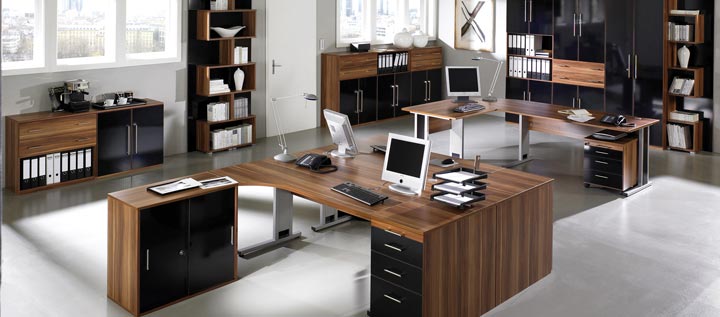In a 2003 survey, 97% of employees said they regarded their place of work as a symbol of whether they were valuable to employers. Another interesting result of the survey found only 37% of people think their office design had been created ‘with people in mind’. Lack of attention when designing offices tends to be due to budget because most businesses cut corners in order to save money. Premises and design often fall under an unnecessary large expenditure when it should really be viewed as an investment. Office design can have a huge impact on the effectiveness of its people and represents a company’s values.
The evolution of the office
Design of office buildings in Europe has evolved over recent decades alongside changing trends in business management. In the 1960’s an office was seen as a communications system with floor plans to suit a free flow of information. 1970’s labour powers in Europe increased meaning offices were seen as a place of social interaction. Due to this, a lot of issues began to arise such as privacy, noise, individual space and more.
Once the 1980’s rolled around, computing and the technological boom did too. Computers became common place in workplaces with a lot of businesses converting to digital practices. Between 1983 and 1985 sponsored searches took place to establish new parameters for office buildings. New parameters helped when coping with IT along with the changing nature of the corporate organisation in Europe and US. Interior design was forced to focus on more than just style and aesthetics and interior designs had to develop their skills.
In the 1990’s a second workplace revolution responded to a realization that I.T. was transforming the way we worked. Technology was affecting the way we socialized, our usual technological and construction processes. By embracing I.T. into the workplace, the need for synchronous communication was reduced. The revolution highlighted the issue of office space is not being optimized. Offices are now required to be more of a social space for interactive engagement.

How is office design different now?
PAST
- Location specific.
- Own space or have long term lease.
- Highly territorial space.
- Strong physical branding.
- Formal structured interaction.
- Physical space and mobile technology.
FUTURE
- Network of locations.
- Short term lease.
- Shared or hired space.
- Varied internal and temporary brand expression.
- Flexibility.
- Operating across virtual and physical space

What type of organisation are you?
When thinking about office design you should consider what type of organisation you are, for example; are your tasks routine and predictable? Or, are they more varied and unpredictable? Ask do you require a varied range of expertise, increased networking and regular personal meetings? If the answer is yes, this will affect the space in which you dedicate to different roles and areas such as needing a more fluid working environment. If your business tends to stick to conventional hierarchies you will need a dedicated computing area/ desks.
Studies have defined building types into to four potential types:
- Obsolete which includes poor location, inaccessible and a low level technological provision
- Underachieving is a good location with good accessibility, but low level of technological provision or adaptability
- Misplaced includes building is adaptable with good levels of technological provision but has a poor location with bad accessibility
- Business value such as great location, highly accessible, flexible and has high levels of technological provision

How does my office building affect business performance?
Office design has had an impact on the following factors of business performance:
- Productivity.
- Motivation and staff retention.
- Knowledge and skills.
- Innovation and creativity.
- Responsiveness to business/ tech change.
- Customer attraction and retention.
- Optimization of total occupancy cost
Office design variables
Who thought office design was just about choosing the right colour wood and walls? Think again! Many factors are to be considered when choosing and decorating an office space. Here is a list of variables that effect employees:
- Site: (Infinite time impact) Buildings context, location, landscaping etc. for example telecoms, local amenities, site security, car parking
- Shell: (50 – 70 years impact) Structure, shape, size, height etc. including floor size, space efficiency, access, exterior/ interior maintainability
- Skin: (25 years impact) Buildings cladding including solar control, natural lighting and ventilation, views, energy efficiency
- Services: (15 – 20 years impact) Heating, light and cable distribution, ventilation etc. Examples include lighting, temperature control, environmental control
- Scenery: (7 – 10 years impact) Fitting of internal elements including ceiling, partitions etc. This can mean factors like quality of materials, eating facilities, break areas, landscaping
- Systems: (approx. 3 years impact) Information and Communication technology. Think about network access and data connections
- Settings: (day to day impact) Furniture and equipment management including furniture, decor, group size
———————————————————————————————————————————
Wow! Intense blog over. Now you know a bit about the science behind office layout and style it may help make sense of a few existing issues or made you aware of potential problems. Don’t worry, we didn’t just pile all of this information on you if we couldn’t help. For inspiration, queries and help contact our knowledgeable sales team who will be happy to assist. We work closely with all of our suppliers to provide the best service for our customers including installation, office planning and even bespoke product design. If you’re interested in any of these services call us today.
Source of stats: https://webarchive.nationalarchives.gov.uk/20110118095356/https:/www.cabe.org.uk/files/impact-office-design-full-research.pdf